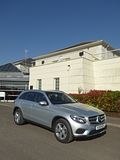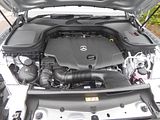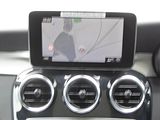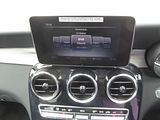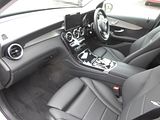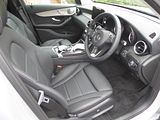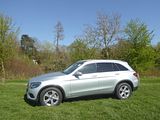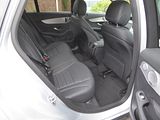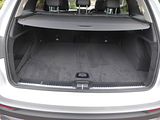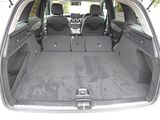With the huge increase in popularity of crossover and SUV type vehicles in recent years, it must have been a surprise to many buyers that whilst BMW and Audi were doing good business selling respectively the X3 and Q5 models to those looking for a premium-badged crossover to accommodate the family and their belongings, a visit to the Mercedes dealer would have resulted in the sales person either trying to sell the larger and costlier GLE (former ML Class) or extolling the versatility of the C Class Estate, a situation which probably frustrated bother seller and buyer. Of course, this was a UK market issue, as following its 2008 launch, in fact Mercedes did have an entrant in this segment of the market with the rather boxy GLK Class, but somehow that car was designed in a way that precluded the building of it with right hand drive. Mercedes did not make the same mistake with its replacement, the GLC, which was launched in 2015, finally giving them the rival they needed not just to take on the X3 and Q5 but a buoyant sector of premium-badged crossovers including Alfa’s Stelvio, the Jaguar F-Pace, Volvo’s XC60 and the Lexus NX among others. Unmistakably a Mercedes, the GLC is very much like the W205 generation C-Class based car with which it shares around 70% of its components. Neatly rounding out a range of crossover Mercedes models, slotting between the smaller GLA and larger GLE, the GLC found ready market acceptance and sales grew pretty quickly, selling more strongly than the GLK in those markets where that car had been offered. Having sampled three of the GLC’s closest rivals, the Q5, X3 and F-Pace in the first few months of 2019 and with memories of a likeable Alfa Stelvio still in my brain from a few months earlier, this was the one car missing from my experience to be able to decide which is my pick of this important market segment, so when Hertz at Heathrow offered me one for a relatively modest upgrade fee, I jumped at the chance to take it and see what I thought.
Mercedes offer the GLC with a variety of petrol and diesel engines, all of them familiar from other models in their range. And like them, the numbering of the specific model does not denote the engine size, but nearly an indication of relative power. Despite all the well-publicised stories about diesel, most GLC models sold in Europe still have diesel power and that was the case for the test car, which, with GLC 220d badging had a 2.1litre turbo 4 unit to power it. It develops 168 bhp. This engine is a pretty good statement of the art of the possible with a modern diesel engine, being generally quiet and refined. There is barely a trace of the once characteristic diesel rattle when you start it up and it is equally well suppressed once on the move. Noise levels are pretty low no matter how you are driving. The GLC 220d features a standard 9 speed automatic transmission. With quite so many ratios, the uppermost ones are fairly close together but even with the 295 lb/ft of torque available, I found that the car would only get into 9th gear at close on 70 mph. As the gearchanges are silky smooth, it really does not matter much which gear you are in, and you probably would not even really know anyway. The gearlever is on the column, as is the case with most Mercedes models these days, There are paddles on the steering column, as well. Such high gearing does help with fuel economy. I had the GLC for a week and covered 676 miles and the car needed 81 litres during that time so I could return it full, which computes to an very respectable 37.88 mpg. Much of that test mileage was done at a steady speed on the motorway and here the hushed manners of the GLC 220d will impress. Whilst the car has adequate levels of power for decent acceleration, it never strikes you as being a fast car, and you probably won’t select if thinking it is. Instead, think of this as a comfortable and composed machine for family transport.
You probably won’t select a GLC if you are looking for the sportiest drive in the class, as it certainly is not. Rivals such as the Stelvio and F-Pace certainly beat it in this regard and so, probably, but it is a much closer thing, does the BMW X3, although my recent experience of that car suggests that it is quite a long way from being an “Ultimate Driving Machine”. The GLC 220d has steering which is very light and pretty devoid of any feel which helps to make the car easy to park and feel quite manoeuverable but which won’t encourage you to find the twisty road home. The handling and road holding are more comfort oriented, too, so whilst the car is perfectly capable on curvier roads, it is not one that is going to give you a memorable experience. Mercedes’ 4Matic all-wheel drive system is standard on all GLC models, and apparently, although I did not test this, this does give the GLC a decent capability off-road, but most will simply be grateful for the extra traction and grip it offers when driving conditions are poor. There are a number of selectable driving modes, which Mercedes calls its Dynamic Control system, ranging from Eco to Comfort, Sport, Sport + and a Customisable one, which do pretty much what you expect in terms of sharpening some of the response, but I am sure most people will do as I did and simply leave it in one mode – Comfort, in my case. Cheaper GLC models have standard springs but there is air suspension available in more costly models and as you progress up the range the standard wheels get larger. Entry level SE cars come with 17″ wheels, but by the time you get to the AMG-Line cars they have reached 19″ and 20″s feature on the high end models. As with so many cars these days, understanding the consequences of your choices here is important, though may be quite difficult experience all he different combinations. The test car had standard springs and 18″ wheels and thus equipped, it had a composed gait, a feeling emphasised by the pliant ride. The brakes were well up to par, of course. All round visibility is about as good as you get in cars of the modern era, with the fairly upright rear end making it easy to judge where the car stops and the rear-view camera confirms things for you. Parking sensors are also a useful addition.
The interior and dash layout of the GLC very much follows Mercedes house style and current thinking. That is not entirely a good thing. Whilst the layout is generally clear and logical, the quality standards are not what you might expect from a car with the three pointed star as its badge. Superficially, all looks good and from a distance or a picture. it looks like a high quality finish but sadly this is some illusory as the reality is that the materials are nothing like as nice to the touch as they are in photos. The metal effect inlays are not exactly classy and the expanses of gloss black plastic show dust and finger marks in equal measure. The leather wheel at least id decent to hold. The instrument cluster comprises two large dials for the speedo and rev counter with the sort of dot gauges for fuel level and water temperature that Mercedes currently favour in the lower portions of the main dials. Between the two main dials is a digital display area for trip computer related data, and you can cycle through all the various options for this with buttons on the steering wheel boss, where you will also find audio repeater functions. A chunky stalk on the left of the wheel is used for indicators and wipers with a matching one on the right serving as the gear lever. A smaller left hand stalk, lower down is used for the cruise control. The light switch is on the dash. The centre of the dash contains the integrated screen for the infotainment system, which is mounted very high, perched on the top of the dash looking a bit like someone stuck an iPad there almost as a after-thought just as you get in the C Class. It is securely mounted, despite appearances, but it is not touch sensitive, so you need to use the buttons and control wheel in the console to operate it or the traditional audio unit knobs and buttons for radio functions. The audio functions use the Audio 20 setup with its 8.4-inch display screen, 5 speakers, DAB radio, a CD slot and Garmin-supplied satellite navigation. Premium Plus models gained the Comand Online system, with hard disc-based navigation. Below the display screen are air vents and the dials and buttons for the dual zone climate control. None of the buttons feel that substantial and you don’t get the “built to last” feeling that used to characterise any Mercedes until a few years ago.
Seat upholstery is with artico, a sort of man-made leather, and again, whilst it is pleasant enough, you get the feeling that it is no better than Mercedes felt they could get away with, and there are rivals who provide nicer. Adjustment for both front seats is all electric with the controls to make those movements on the door, laid out in a patter matching the elements of the seat. There is a wide range of adjustment possible so those who are short or tall and with differing proportions should all be able to get the driving position they want. There is a pull-out bolster under the thighs for those who are long-boned in this area – which is most definitely not me. The seat did prove comfortable and the SUV-styling of the GLC means that there is a feeling of spaciousness with headroom in particularly generous supply, though the wide and relatively high centre console may make you feel a bit hemmed in. The Sport trim of the test car includes heated front seats.
There is ample room in the back of the GLC, too. Even with the front seats set well back, there should be sufficient legroom to accommodate the taller of passengers, and headroom is definitely not in short supply. Whilst there is not that much of an intrusion from the central transmission tunnel, the centre console unit does come quite a long way back and is very high, so a middle seat occupant would have to find a means of straddling this. There is a drop-down central armrest, with cup holders in the upper surface and odds and ends can be put in the map pockets on the back of the front seats or the pockets on the doors.
There is a good sized boot here. The shape is nice and regular and there is ample depth under the load cover as well as good length and the boot floor is flush with the base of the tailgate so sliding large and heavy items is going to be as easy as it gets. The rear seat backrests are split 40/20/40 and, with electrical assistance, simply drop down onto the seat cushions to create a much longer and flat load area. Inside the cabin, the GLC follows the norm of having a decent sized glovebox, a cubby under the central armrest and pockets on the doors for the odds and ends that everyone tends to accumulate. There is a large lidded area as the dash turns into console which hides the cupholders.
There’s a wide range of GLC models, with straight Mercedes as well as AMG badging and it has evolved since the 2015 launch of the car with some of the slower-selling engine options disappearing from the line-up. Selecting the engine is the start point, with a pair of diesels currently on sale, the GLC220d of the test car and more potent GLC300d, the previous GLC250d and GLC350d having been dropped, and a lone petrol the GLC300 before you get to the AMG GLC43 and full-fat GLC63 cars. All have standard 4Matic all-wheel drive. Entry level trim is the SE and this is followed by Sport, which despite the name is actually rather comfort-oriented in spec and then there are various AMG Line versions before you get to the proper AMG trim. There are a vast number of options, available individually or in packages on top of this, so configuring your ideal spec GLC will take a while. The range starts with the SE whose spec includes 17-inch wheels, keyless starting, dual zone automated climate control and artificial leather seats with electric adjustment. There is an electrically opening tailgate a rear-view camera and all-round parking sensors. Above this is the Sport, which adds 18-inch wheels, heated seats, Garmin satellite navigation and LED headlights. You can add the best of the Sport features to SE trim by adding the SE Premium package, which costs half the price of the upgrade in spec. The rare Urban Edition features 20-inch wheels and intelligent LED headlights. AMG Line models add 19-inch five-twin-spoke AMG alloy wheels; AMG sports suspension with selective damping; AMG bodystyling including AMG front apron with sporty air intakes and chrome trim element; AMG sports seats in Artico/Dinamica upholstery; and diamond radiator grille. AMG Line Premium models feature all of this equipment and add Multibeam LED headlights; running boards; 12.3-inch digital instrument cluster display; ambient lighting; augmented navigation; 20-inch multi-spoke AMG alloy wheels; smartphone integration; and AMG sport seats in leather upholstery. AMG Line Premium Plus models add a panoramic glass sunroof; Burmester surround sound; Keyless-Go Comfort package; memory seats; and 20-inch five-twin-spoke AMG alloy wheels. AMG Line Premium Plus Ultimate models feature all of the above equipment and add Air Body Control including air suspension for front and rear axles with continuously adjustable damping. As ever, the price tag can increase significantly from the headline grabbing starting point.
Reading through this review, you would conclude that the GLC is a good car, as there are no significant weaknesses that I uncovered in my week driving it. The GLC is roomy for people and luggage, goes well enough, decently economical and a comfortable companion for a journey, short or long. Whilst the interior quality does not feel anything like as well-engineered as Mercedes products of yore, it is not really any worse than any of its rivals, so no minus marks there, either. But it does compete in a crowded market, and unless you are a die-hard Mercedes person through and through, you will surely look at its rivals as well, and it will be a tough choice. Just as I concluded in my recent write-up of the BMW X3 that the BMW would not be my pick, nor would this Mercedes. Even if you agree with this, and many won’t, there is one factor which could tip things the GLC way (of the BMW way, for that matter). these two German giants have seen their sales grow not just because of the vast range of products they both offer but also because of the aggressive finance deals that they can offer, with monthly payments that can be literally hundreds of pounds lower than those of apparently similar priced rivals from Alfa Romeo and Jaguar. Whilst their products are both ones I would pick over the GLC and X3, if, say it was a rental car, if it is one you are paying for over many months or years, then it would be a much harder decision to make.











































